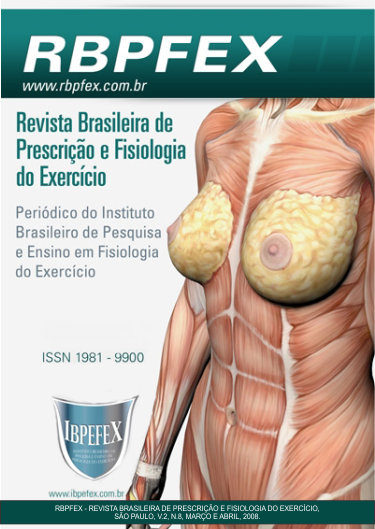Evaluation of blood lactate levels in professional soccer players during matches – “2007 Mato Grosso State Championship”
Abstract
The aim of this study was to analyze the blood lactate behavior in professional soccer players in order to measure the demand of lactic anaerobic metabolism during a soccer match, useful for training prescription. The tests were carried out during matches of the 2007 Mato Grosso State Championship. 13 athletes who belong to “UNIÃO ESPORTE CLUBE”, in the city of Rondonópolis – MT, with an age average of 25 ± 4.14, weight 71.78 ± 8.93 and height 175 ± 0.07 cm participated in the present stud. A portable lactate analyzer (Accutrend® Lactato) was used. Results demonstrated an average of 4.63 ± 0.91 mmol/l after the first half-time and 3.68 ± 0.57 mmol/l at the end of the game in all athletes. When separated by positions, only wingers and midfielders presented values above 4 mmol/l (6.0 ± 2.2 mmol/l and 4.33 ± 1.25 mmol/l for wingers and 4.33 ± 1.85 mmol/l and 4.01 ± 1.81 mmol/l for midfielders). Defenders and forwards presented values of 4.1 ± 0.65 mmol/l and 3.15 ± 0.68 mmol/l; 4.1 and 3.24 ± 0.55 mmol/l respectively. The fact of a team try to incessantly obtain score equality, the need of winning a game or being in advantage related to scores, can contribute to the metabolic predominance of a match. The physical weariness during the first half-time, the performance reduction and depletion of some nutrients during a match can explain the decrease of lactate concentration from the first to the second half-time.
References
- Aoki, M.S. Fisiologia, Treinamento e Nutrição aplicados ao Futebol. Jundiaí – SP. Fontoura, 2002.
- Balikian, P.; Lourencao, A.; Ribeiro, L.F.P.; Festuccia, W.T.L.; Neiva, C.M. Consumo Máximo de Oxigênio e Limiar Anaeróbio de Jogadores de Futebol: Comparação entre as diferentes posições. São Paulo. Revista Brasileira de Medicina do Esporte. Vol. 8. Num. 2, p. 32-37. março/abril 2002.
- Barbanti, V.J. Treinamento Físico: Bases Científicas. 3ªed. São Paulo. CLR Balieiro, 1996.
- Bompa, T.O. Periodização: Teoria e Metodologia do Treinamento. São Paulo. Phorte Editora. 2002.
- Frainer, D.E.S.; Oliveira, F.R.; Pazin, J. Influência da Maturação Sexual, Idade Cronológica e Índices de Crescimento no Limiar de Lactato e no Desempenho da Corrida de 20 minutos. São Paulo. Revista Brasileira de Medicina do Esporte. Vol. 12. Num. 3. p. 139 -144. maio/junho 2006.
- Frisselli, A.; Mantovani, M. Futebol: Teoria e Prática. São Paulo. Phorte Editora. 1999.
- Gonçalves, G.A. Escolinhas de Futebol para Crianças: Expectativa dos Pais de Alunos. Estudos: Revista da Universidade Católica de Goiás. Goiânia. Vol. 31, Num. 1, p. 185 – 206. Janeiro 2004.
- Martin, V. Futebol: Lactato e Amônia Sanguíneos em Teste de Velocidade Supra-Máxima. São Paulo. Escola de Educação Física e Esporte, Universidade de São Paulo. 2002.
- Mcardle, W.; Katch, F.I.; Katch, V.L. Fisiologia do Exercício: Energia, Nutrição e Desempenho Humano. 5ª ed. Rio de Janeiro. Guanabara Koogan. 2003.
- Pereira, B.; Souza Junior, T.P. Metabolismo Celular e Exercício Físico – Aspectos Bioquímicos e Nutricionais. São Paulo. Phorte Editora. 2004.
- Powers, S.K.; Howley, E.T. Fisiologia do Exercício: Teoria e Aplicação ao Condicionamento e ao Desempenho. 3ª ed. São Paulo. Editora Manole. 2000.
- Silva, P.R.S.; Andrade, A.; Rica, W.O.; Visconti, A.M.; Ponte, F.M.; Rosa, A.F.; Costa, S.B.; Roxo, C.D.M.N.; Machado, G.S.; Souza, J.M. Perfil de Limiares Ventilatórios durante o Exercício e o Consumo de Oxigênio de Pico verificado em Jogadoras de Futebol. Revista Brasileira de Medicina do Esporte. São Paulo. Vol. 5 Num. 4. p. 132-137. julho/agosto 1999.
- Silva, P.R.S.; Inarra, D.A.; Vidal, J.R.R.; Oberg, A.A.R.B.; Fonseca Junior, A.; Roxo, C.D.M.N.; Machado, G.S.; Teixeira, A.A.A. Níveis de Lactato Sanguineo, em Futebolistas Profissionais, Verificados após o Primeiro e o Segundo Tempos em Partidas de Futebol. São Paulo. Revista Acta Fisiatrica. Vol. 7. Num. 2. p. 68 – 74. 2000.
- Silva, P.R.S.; Romano, A.; Teixeira, A.A.A.; Visconti, A.M.; Roxo, C.D.M.N.; Machado, G.S.; Vidal, J.R.R.; Inarra, L.A. A importância do Limiar Anaeróbio e do Consumo Máximo de Oxigênio (VO2 máx.) em Jogadores de Futebol. Revista Brasileira de Medicina do Esporte. São Paulo. Vol. 5. Num. 6. p. 225 – 232. novembro/dezembro 1999.
- Silva, P.R.S.S.; Romano, A.; Visconti, A.M.; Teixeira, A.A.A.; Roxo, C.D.M.N.; Machado, G.S.; Rebello, L.C.W.; Souza, J.M. Efeito do Tempo de Intervalo da amostra Ventilatória na Variabilidade do Consumo Máximo de Oxigênio (VO2 máx) em Jogadores de Futebol Profissional. Revista Brasileira de Medicina do Esporte. São Paulo. Vol. 5, Num. 2. p. 43 – 47. março/abril 1999.
- Souza, J.; Zucas, S.M. Alterações da Resistência Aeróbia em Jovens Futebolistas em Período de 15 semanas de Treinamento. Revista de Educação Física. Maringá. Vol. 14. Num. 1. p. 31 – 36. 1º semestre 2003.
- Wuolio, J. Futebol, o Jogo mais Popular. Enciclopédia Salvat da Saúde. Rio de Janeiro. Salvat Editora do Brasil. 1981.
Authors who publish in this journal agree to the following terms:
- Authors retain the copyright and grant the journal the right of first publication, with work simultaneously licensed under the Creative Commons Attribution License BY-NC which allows the sharing of the work with acknowledgment of the authorship of the work and initial publication in this journal.
- Authors are authorized to enter into additional contracts separately for non-exclusive distribution of the version of the work published in this journal (eg, publishing in institutional repository or book chapter), with acknowledgment of authorship and initial publication in this journal.
- Authors are allowed and encouraged to post and distribute their work online (eg, in institutional repositories or on their personal page) at any point before or during the editorial process, as this can bring about productive change as well as increase impact and impact. citation of published work (See The Effect of Free Access).






